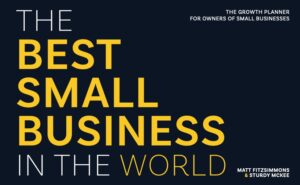Greg Crabtree lays out what he calls “The Four Keys” in Section 1 of his book, “Simple Numbers, Straight Talk, Big Profits!”. These are the “4 keys to unlock your business potential” based on his experiences as an accountant, entrepreneur, and consultant to entrepreneurs.
Section 1, the first four chapters, is so impactful and  foundational to growing and operating any business, that I think it should be mandatory reading for all, especially new, business owners. Many of the lessons in Section 1 are lessons that I learned the hard way, over 19+ years, and through many mistakes. Some of them I am only just now getting a handle on. I can’t help but wonder how things would be different if I had read these 4 chapters 15 years, or even 2–3 years, ago. But as with so many things, the teacher appears when the student is ready. And maybe the content of these chapters were presented to me along my journey in different ways, and I was just not ready for them? Either way, they truly are “Key”, and bear reading and sharing.
foundational to growing and operating any business, that I think it should be mandatory reading for all, especially new, business owners. Many of the lessons in Section 1 are lessons that I learned the hard way, over 19+ years, and through many mistakes. Some of them I am only just now getting a handle on. I can’t help but wonder how things would be different if I had read these 4 chapters 15 years, or even 2–3 years, ago. But as with so many things, the teacher appears when the student is ready. And maybe the content of these chapters were presented to me along my journey in different ways, and I was just not ready for them? Either way, they truly are “Key”, and bear reading and sharing.
This brief summary is in no way a substitute for Greg’s book. I highly recommend that you buy it. Read it. Study it. Take notes. And most importantly, apply it in your business. I feel so strongly about this that I am giving copies to all of my coaching clients, and also doing a giveaway of 4 more copies to people in my Focus Forward Starter Group on Facebook.
What I hope to do here is provide you with a little background on why Greg’s lessons are so important and maybe help you avoid making the same mistakes I, and many others, have made.
Chapter 1: Owner’s Salary
“It’s my company — why can’t I pay myself whatever I please?”
Greg advocates very strongly that you take a market based salary as your compensation to give yourself a real picture of the health of your business. Messing with this number distorts the rest of your business’s numbers and gives you a false picture of the health of your business.
One key in setting your market based salary is the idea that “You get paid a salary for what you do, and you get a return on what you own.” Keeping the two separate by being a demanding employee and a demanding shareholder allows you to demand that you get paid what you are worth, and that you also realize a good return on your investment.
A market-based wage allows you to truly see your real net income number without distortions, and to better gauge the health of your business. Don’t underpay yourself and then be proud of how much money your business is making. It doesn’t line up.
A metaphor Greg uses is to treat your business like a cow, a cash cow. He says, “Your Business is Like a Cow. Your goal is to keep the cow healthy so you can milk it every day.” If you do not keep it healthy enough to milk, then he offers the alternative, “Or you can have one barbecue.” You have to choose one. Because you cannot have both a barbecue today and milk in the coming months.
Chapter 2: Profit
“Sales are for show, profits are for dough!”
Too many entrepreneurs focus on their top line number and growth. They focus on how many employees and locations they have. I know! I did this.
I grew a company to >4x it’s previous size with all the stresses and complexities associated with a 6 location, 40++ employee operation. And I made less profit. My wife wasn’t happy. Employees could not understand why we were cash strapped. People were worried about our stability. I wasn’t happy. And I took away from this experience that success is not your size, but your ability to execute on your purpose, your vision, and your strategy. And, as Greg puts it, profit is like oxygen to your business. Without it, your business is on life support. You are operating on borrowed time (and borrowed money).
Greg also defines 10% profit as the new break even. He goes into compelling detail about why you need at least 10% profit and where it goes. He also takes the mystery out of EBITDA and redefines what profit should take into account in a small business, namely EBT (earnings before taxes).
This listing is from page 23 of Chapter 2. Where does your business fall?
- 5% or less of pretax profit means your business is on life support.
- 10% of pretax profit means you have a good business.
- 15% or more of pretax profit means you have a great business.
Any additional compensation you receive, like a car lease, etc. should come out of your owner compensation — your salary or wages. All of your compensation combined can all be part of your owner’s salary. But account for it that way before you calculate your profit number.
Greg then talks about making it through “the Badlands” from $1M to $5M. He compares this journey to the wagon trains from St. Louis to the Pacific. You will be traveling through a land without resources. So you will have to protect your profit and have plenty of reserves in place to make it through this long and treacherous journey. If you don’t have all the resources in place and a plan to preserve your profit, your business will either die along the way, or you will be forced to turn back. Neither is an appealing option. So, plan it out, and make sure you have what you need to make it through the Badlands.
Chapter 3: Labor Productivity
“The teams that win are the teams that get the most productivity for every dollar of labor.”
I think Greg would agree with Jack Daly’s opinion that “there are no expenses in business, only investments.” The money you spend on everything should turn in to more money. You are running a business, not a hobby. Your inputs, not just in money, but in time, effort, energy, emotional energy, and more should create a return for you. That is the point of a business.
Greg likes to use labor dollars instead of full time equivalent (FTE) employees because head count does not reflect your profit model. The money spent on labor is a more direct way of analyzing your profit model. After all, if you can get the same productivity from less money input, this is an improvement in efficiency, as is more productivity from the same labor dollar. This is why companies move manufacturing to places where wages are lower, even if productivity is lower. It’s the ratio, not just the price.
Growth by itself does not turn into more profit. Companies often hire to support their top line revenue growth and fail to address their profitability, hoping it will work out. A gross profit increase must come with each new hire, as must management and efficiency in each position, to ensure they are producing what they were hired for. There will be stress and tension as productivity is maxed out prior to each new hire, which in turn will relieve the stress for a while by taking on the extra work your team was doing. They, and you, should know this and plan for it. Relieving the stress too soon undermines your profit. Too late, and you may end up taking steps backwards due to decreased productivity capacity.
Hire smart. Designing positions around the functional needs of your business rather than designing positions around individuals will allow you to find the right players for the right positions. It will also allow you to be deliberate in deciding what functions you should keep, what your current team can do, and what you need new people to do. And you will want to continually monitor for when people hit their ceiling, whether it is in management or another role. As your business grows, so will its needs.
Greg goes on to explain that in a certain way your business is like the NFL (National Football League). For those not familiar, the NFL has imposed salary caps for all the teams with the goal of creating a semblance of parity and to keep competition among the teams interesting. But in this environment there are teams that still excel. Greg makes the case that they do so through greater labor efficiency, and that is certainly one component. But the point he is really making is that you also have a salary cap.
Your salary cap is dictated by your target profit, and your overhead or non-salary costs. Basically, your revenue is 100%. That is all it can be. If you have a profit target of 10%, and a non-salary cost target of 40%, then 50% of your revenue is available for salaries and compensation. If you spend more than 50% where does that come from? It comes from your profit. He provides illustrations, tables, examples, and strategies to manage your salary cap.
And finally in Chapter 3 Greg lays out and illustrates cash flow and profit scenarios to make a very compelling case for protecting and monitoring your profit closely. “The higher your pretax profit, the quicker you reach a cash-positive state.”
Chapter 4: Business Physics: The Four Forces of Cash Flow
“Cash is the most powerful opportunity magnet ever created.”
The four forces of cash flow Greg lays out as:
- Paying your taxes
- Repaying debt
- Reaching your core capital target
- Taking profit distributions
These may not be in the order you want or expected. But following these rules, in this order will allow you to build a far more stable business that is poised for growth and future success.
One key point that runs counter to much conventional wisdom is do not spend down your profit to pay less in taxes. His point is that if you buy a $50,000 SUV at the end of the year in order to “save” money on taxes you now have a depreciating asset, something that is not generating revenue for your business, and you do not have the $50,000. If you kept it, you might pay 40% in taxes, but that means you would still have $30,000 left to reduce your debt, add to your core capital, or to distribute to yourself and your shareholders.
This approach ultimately leads to improved stability and better positioning for future growth.
And that is just a brief look at the first 4 chapters. The remainder of the book goes in to greater detail and dives deep into lessons that will help your business grow, survive, and thrive.
Join us over at the Focus Forward Starter Group to discuss this and other business topics. And make sure to pick up Greg’s book, “Simple Numbers”.
Have questions? Book a time to talk with Sturdy.
